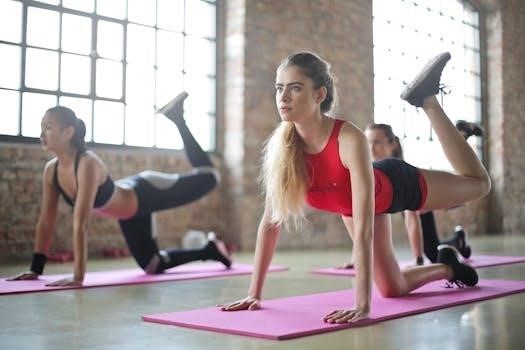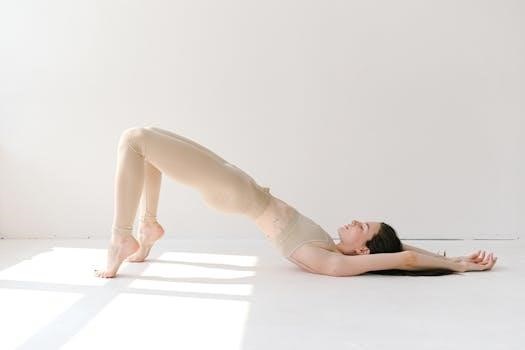Pilates Exercises for Beginners PDF⁚ A Comprehensive Guide
Embark on your Pilates journey with this comprehensive guide, tailored for beginners. Discover numerous free downloadable PDF resources that offer beginner-friendly matwork exercises and lesson plans. These resources cater to all fitness levels, providing workout routines from short sessions to structured programs, aiding in overall fitness improvement.
Pilates, a unique and low-impact exercise, offers a fantastic way to condition your entire body. It focuses on toning muscles, improving posture, and increasing flexibility through controlled movements. Ideal for beginners, Pilates emphasizes core strength, targeting deep abdominal and pelvic floor muscles. A strong core supports better posture, reducing the risk of back pain, a common concern, especially for women.
Pilates is easily modified, making it accessible for everyone, regardless of fitness level. Whether you’re looking to brush up on the foundations or start a new fitness journey, Pilates offers a great starting point. The practice is all about form, not depth, ensuring you reap the benefits effectively.
For those new to Pilates, online resources provide a wealth of information, from free downloadable PDFs with matwork exercises and lesson plans to comprehensive guides. These guides often include step-by-step instructions, demonstration photos, and modifications for various exercises. With consistency and proper form, Pilates can be a transformative practice for overall well-being.
Pilates is more than just a workout; it’s a holistic approach to fitness, combining flexibility and strength from both Eastern and Western cultures.
Benefits of Pilates for Beginners
Pilates offers a multitude of benefits, especially for beginners seeking a low-impact yet effective workout. Primarily, Pilates strengthens the core muscles, which include the deep abdominals and pelvic floor. A strong core is crucial for supporting the spine, improving posture, and reducing the risk of back pain. This is particularly beneficial for individuals who spend long hours sitting or those recovering from injuries.
Beyond core strength, Pilates enhances flexibility, balance, and body awareness. The controlled movements and focus on proper form promote better alignment and coordination. Pilates also improves muscle endurance and overall strength without adding bulk, leading to a toned and sculpted physique. This makes it an excellent choice for those looking to enhance their physical appearance without high-impact exercises.
Moreover, Pilates incorporates breathing techniques that can reduce stress and improve mental clarity. The mindful focus required during each exercise helps calm the mind and promotes a sense of well-being. For beginners, Pilates is a gentle yet challenging way to improve both physical and mental health, laying a solid foundation for a lifetime of fitness.

Pilates can also be a complementary workout to other fitness activities.
Essential Pilates Principles for Beginners
For beginners venturing into Pilates, understanding the core principles is fundamental to maximizing benefits and preventing injuries. Centering is the cornerstone, emphasizing the engagement of the deep core muscles to stabilize the spine and pelvis. This “powerhouse” activation is essential for all movements, providing a stable base from which to work.
Control is another vital principle, focusing on precise and deliberate movements rather than momentum. Each exercise should be performed with careful attention to form, ensuring that the correct muscles are engaged and the body is properly aligned. This control minimizes the risk of strain and enhances the effectiveness of each movement.
Breathing plays a crucial role in Pilates, coordinating with movements to enhance core engagement and promote relaxation. Proper breathing techniques, such as inhaling deeply into the ribcage and exhaling fully to engage the abdominals, help to improve oxygen flow and release tension. Precision involves maintaining proper alignment and form throughout each exercise, ensuring that the body is working efficiently and effectively.
Finally, flow emphasizes smooth and continuous transitions between exercises, creating a seamless and graceful workout. By integrating these principles, beginners can develop a strong foundation in Pilates and experience its full range of benefits.
Pilates Mat Exercises for Beginners (PDF Availability)

Pilates mat exercises form the bedrock of any Pilates practice, especially for beginners. They utilize body weight as resistance, making them accessible and adaptable for various fitness levels. A range of PDF resources are available online, offering step-by-step instructions and visual aids to guide beginners through these exercises effectively. These PDFs often include modifications to suit individual needs and abilities.
The “Hundred” is a classic mat exercise that warms up the core and improves circulation. “Rolling Like a Ball” enhances spinal mobility and core control. “Single Leg Circles” target hip stability and flexibility. “Spine Stretch Forward” increases spinal articulation and hamstring flexibility.
These exercises are designed to strengthen the core, improve posture, and increase flexibility. The availability of free downloadable PDFs makes it easy for beginners to learn and practice these exercises at home, at their own pace. These resources typically include detailed descriptions of each exercise, along with images or videos demonstrating proper form. By following these guides, beginners can build a strong foundation in Pilates and progress to more advanced exercises over time. Regular practice of these mat exercises can lead to improved body awareness, reduced back pain, and enhanced overall well-being.
Core Pilates Exercises for Beginners
Pilates is renowned for its emphasis on core strength, making it an ideal exercise method for beginners seeking to develop a strong and stable center. Several fundamental Pilates exercises specifically target the core muscles, providing a solid foundation for more advanced movements. These exercises focus on engaging the deep abdominal muscles, lower back, and pelvic floor, working together to create a supportive and functional core.
The “Hundred” is a quintessential core exercise that involves lying on your back and pumping your arms while maintaining a lifted head and chest. “Single Leg Circles” not only improve hip mobility but also require significant core stabilization. “Rolling Like a Ball” challenges core control and spinal articulation.
These exercises are designed to improve core stability, posture, and overall body awareness. By consistently practicing these core-focused Pilates exercises, beginners can develop a strong and resilient core, which is essential for supporting the spine, preventing injuries, and enhancing athletic performance. Remember to focus on proper form and controlled movements to maximize the benefits of these exercises and minimize the risk of strain or injury. As core strength improves, beginners can gradually progress to more challenging variations and exercises to continue building a solid foundation.
Pilates Exercises for Lower Back Pain (PDF Guide)
Pilates offers a gentle yet effective approach to managing and alleviating lower back pain, making it a suitable exercise modality for beginners experiencing discomfort in this area. Several Pilates exercises are specifically designed to strengthen the core muscles, improve spinal alignment, and increase flexibility, all of which contribute to reducing lower back pain.
Pelvic tilts are a foundational exercise that helps to improve awareness of spinal positioning and engage the abdominal muscles. The “cat-cow stretch” promotes spinal mobility and releases tension in the back muscles. “Bird dog” exercises enhance core stability and balance while strengthening the back and glutes.
To guide beginners in performing these exercises correctly and safely, a dedicated PDF guide is available for download. This PDF provides detailed instructions, including step-by-step explanations and illustrative photos, ensuring that individuals can perform the exercises with proper form and technique. By consistently practicing these targeted Pilates exercises with the aid of the PDF guide, beginners can experience significant relief from lower back pain, improve their posture, and enhance their overall spinal health.

Pilates Breathing Techniques for Beginners
Pilates emphasizes a unique breathing technique that is integral to the effectiveness of the exercises. Known as lateral or thoracic breathing, it involves inhaling deeply into the ribcage, allowing it to expand sideways and backwards, while maintaining abdominal engagement. This technique differs from traditional diaphragmatic breathing, where the abdomen expands during inhalation.
For beginners, mastering lateral breathing can be challenging but crucial. Proper breathing in Pilates promotes core stability, enhances muscle control, and improves circulation. It also helps to calm the nervous system and reduce stress, making the exercises more mindful and effective.
To learn Pilates breathing, lie on your back with knees bent and feet flat. Place your hands on your ribcage and focus on expanding your ribcage as you inhale and contracting it as you exhale. Maintain a gentle engagement of your abdominal muscles throughout. Coordinate your breath with each movement, inhaling during the preparation phase and exhaling during the exertion phase.
Regular practice of Pilates breathing techniques will not only enhance your Pilates workouts but also promote overall well-being by improving respiratory function and reducing tension.
Pilates Warm-up Exercises for Beginners
Before diving into Pilates exercises, a proper warm-up is essential to prepare the body and mind. The warm-up increases blood flow to the muscles, improves joint mobility, and enhances neuromuscular coordination. It also helps to prevent injuries and promotes a more effective workout. For beginners, focusing on gentle, controlled movements is key.
Start with simple breathing exercises to connect with your core and center yourself. Follow with gentle spinal movements, such as cat-cow stretches, to improve flexibility and mobility in the spine. Include arm circles and leg swings to warm up the shoulder and hip joints. Add gentle core activation exercises, like pelvic tilts and abdominal compressions, to engage the deep abdominal muscles.
Focus on maintaining proper alignment and control throughout the warm-up. Listen to your body and avoid pushing yourself too hard, especially if you are new to Pilates. The warm-up should gradually increase your heart rate and prepare your muscles for the exercises ahead.
By incorporating these warm-up exercises into your Pilates routine, you will enhance your performance, reduce the risk of injury, and promote a more enjoyable and effective workout.
Pilates Cool-down Exercises for Beginners
After completing your Pilates workout, it is essential to incorporate cool-down exercises to gradually lower your heart rate, relax your muscles, and promote recovery. A proper cool-down helps to prevent muscle soreness, improve flexibility, and restore balance to the body and mind. For beginners, focusing on gentle stretches and relaxation techniques is key;
Begin with deep breathing exercises to calm the nervous system and reduce stress. Follow with gentle stretches targeting the major muscle groups worked during the Pilates session, such as the hamstrings, hip flexors, and back muscles. Hold each stretch for at least 30 seconds, focusing on releasing tension and lengthening the muscles.
Include spinal twists to improve mobility and flexibility in the spine; Add gentle stretches for the neck and shoulders to release any tension accumulated during the workout. Finish with a relaxation exercise, such as Savasana (corpse pose), to promote deep relaxation and mental clarity.
Focus on maintaining proper alignment and control throughout the cool-down. Listen to your body and avoid pushing yourself too hard. The cool-down should leave you feeling relaxed, refreshed, and rejuvenated, promoting a sense of well-being and preparing you for the rest of your day.
Modifications and Progressions for Beginners
Pilates is highly adaptable, making it suitable for individuals of all fitness levels. For beginners, understanding modifications and progressions is crucial for a safe and effective practice. Modifications allow you to perform exercises with proper form, regardless of your current strength or flexibility. Progressions, on the other hand, gradually increase the challenge as you gain strength and control.
When starting, focus on mastering the basic movements with correct alignment and technique. If an exercise feels too difficult, explore modifications that reduce the range of motion, decrease resistance, or simplify the movement. For example, you can modify the Hundred by keeping your head down or bending your knees.
As you become more comfortable and stronger, gradually progress the exercises by increasing the range of motion, adding resistance, or performing more repetitions. For instance, you can progress the Roll-Up by reaching further forward or performing it with straight legs. Remember to maintain proper form throughout the progressions.
Listen to your body and avoid pushing yourself too hard, especially when starting. Gradual and consistent progress is key to building strength, flexibility, and control. Work with a qualified Pilates instructor who can provide personalized guidance and modifications to suit your individual needs and goals. Regular practice and patience will lead to significant improvements over time.
Free Pilates Lesson Plans and Resources (PDF Downloads)
To support your Pilates journey, numerous free lesson plans and resources are available online in PDF format. These downloads offer structured workouts, exercise guides, and helpful tips for beginners. Many websites and Pilates instructors provide these resources to make Pilates accessible to everyone.
Beginner-friendly lesson plans typically include a warm-up, a series of mat exercises targeting core strength, flexibility, and body awareness, and a cool-down. These plans often come with detailed instructions and illustrations to ensure proper form and technique.
PDF exercise guides provide step-by-step instructions and visual aids for individual Pilates exercises. These guides often include modifications and progressions to suit different fitness levels. Some resources focus on specific areas, such as core strengthening or back pain relief.
When choosing free resources, look for reputable sources and qualified instructors. Ensure that the lesson plans and exercises are appropriate for beginners and that they emphasize proper form and safety. You can also find downloadable Pilates worksheets to track your progress and create your own personalized workout routines.

Take advantage of these free resources to explore the world of Pilates and discover the benefits of this effective exercise method. Remember to consult with a healthcare professional or certified Pilates instructor before starting any new exercise program.